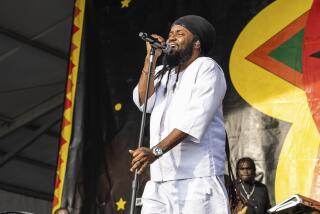Director Kasper Collin brings jazz great Lee Morgan’s tragic love story to West Coast
On a snowy night in February 1972, Helen Morgan reached into her bag and pulled out the pistol her husband, Lee, had bought her.
Lee, a 33-year-old jazz trumpeter who’d risen to fame as a teenager, was getting ready to perform at Slug’s Saloon, a nightclub in New York City’s East Village. His mistress Judith was seated by the door. They’d arrived together.
Helen impulsively let off a shot at Lee, hitting him in the chest. The shooting, in front of friends and fans, wasn’t immediately fatal; Lee bled to death after an ambulance took almost an hour to arrive because of the snowy conditions. Helen pleaded guilty to second-degree manslaughter and served a brief stint in prison before retreating into obscurity.
Lee is now the focus of a documentary, “I Called Him Morgan,” by Swedish filmmaker Kasper Collin. The film, which opens Friday, features archival footage of the trumpeter, snippets of his music and interviews with the people closest to him and his wife, including friends and former bandmates. The documentary, which was released last year but is just now making its West Coast premiere, also features audio from a cassette interview with Helen, who died in 1996.
The Times caught up with Collin to talk about jazz, complex love stories and that fateful night in 1972.
Why did you choose now to tell the Morgans’ story?
I think it was seven or eight years ago now that I was watching YouTube and by chance just found this incredible clip of Lee Morgan performing with Art Blakey and the Jazz Messengers in Japan in 1961. They were playing a composition called “Dat Dere” by Bobby Timmons, and it was Lee Morgan’s solo. I had never heard anyone play the trumpet like that before, and it was just incredibly moving, a real knockout for me. I had listened to a lot of jazz, but I’d never listened so much to Lee, I never realized [how great he was]. So from there, I became very interested in him and his music and started to think about the possibility of making a film.
[In my initial research] I realized there are quite a few people around still [who knew Lee], and I started talking with them. And most of them started to talk about the last four years of Lee Morgan’s life and about the relationship he had had with a woman named Helen. And they talked very positively and lovingly about her and said that she had helped him back, almost saved him from a heroin addiction that threatened to kill him. And then I realized this was the same woman who had shot him. I didn’t know about this almost Shakespearean or Greek tragedy story [until then]. And also, when people talked about her, it was a lot of mixed feelings, [and] I realized they were as close friends to Lee as to Helen. On that very sad night when Lee died, when Helen shot him, the people around didn’t lose just one of them, they lost two good friends.
What is the significance of this story outside the jazz community?
It’s a wonderful introduction into the world of this music. But also, it’s this story about this woman, Helen, who came from poverty and poor circumstances outside of Wilmington in North Carolina. She’d had her first child at 13 and her second at 14 and then left her children behind her and went on a journey, really. She ended up in New York, where she created a new life and became Lee Morgan’s manager, after she had found him and brought him back and helped him. She really re-created herself, and that’s kind of remarkable. Then this very unfortunate event happened where she killed Lee Morgan, and after that, she returns home to the southern U.S. So we have her journey through the film, which is a very fascinating story.
What did you end up thinking of Helen?
[Even] as we kind of navigate toward this unavoidable last evening, I have a responsibility as a filmmaker, as a director, to portray people as complex human beings, as we all are. And that’s what I tried to do with the means possible, because, looking back, the only thing we have are memories: those fragments of her voice, his voice, all the still pictures, his fantastic music, all the memories from the people that were there. It’s all memory material that I’m working with. And I kind of liked that it all ended in this blizzard, this snowy night, and it’s kind of dreamlike when you look at it. But at the same time, they had a great time together. Up until then, there were a lot of joyous moments like in all relationships. But as for what I think about Helen, I’m not the judge, she was a human being. It’s almost like there are two protagonists in that case.
In the audio recording, Helen speaks about how she called Lee “Morgan,” rather than by his first name. Why choose this quote for the film’s title?
It’s very representative for the film, and it gave the film a direction when we were editing it. And it was a title I liked, it was a title that also, in a way, says something about their complex relationship, I think, even if you don’t understand it in the beginning. You can tell the complexities in the relationship. Also, because the film is partly told from her perspective, that’s something unique as well, that we actually see this world from her perspective. But I want to be very, very clear that this is a love letter to both Lee and Helen and that amazing music that brought them together. I can’t imagine my life without this kind of music, so it’s really a love letter to everyone that makes this music possible, and that includes Helen.
follow me on twitter @sonaiyak
More to Read
Only good movies
Get the Indie Focus newsletter, Mark Olsen's weekly guide to the world of cinema.
You may occasionally receive promotional content from the Los Angeles Times.







